Springtime garden glow
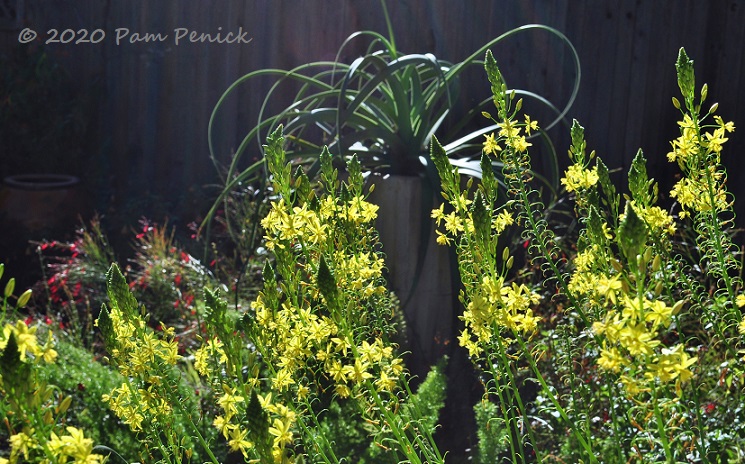
Responding to warm temps and a good rain this week, the garden is awash with new growth and pockets of spring color, like glowing yellow bulbine. Mild winter temps didn’t kill it back, and now each bloom spike is a yellow sunbeam.
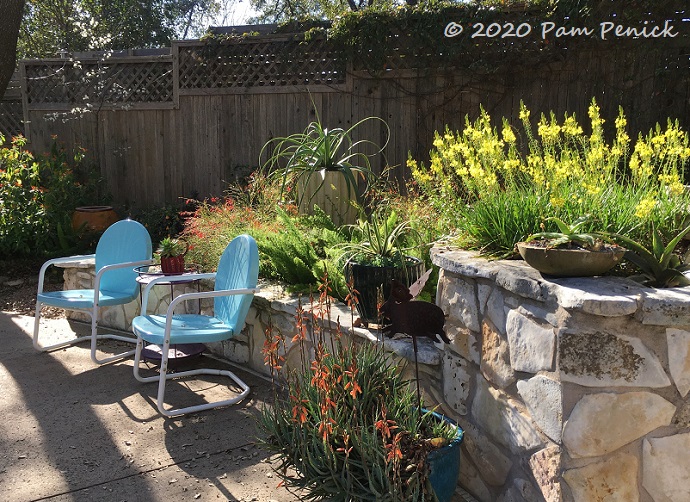
The coral-red flowers of ‘Blue Elf’ aloe (in the blue pot on the patio) are calling to the first hummingbirds returning from Mexico. I hope to see one soon. In the background, red firecracker fern and the white blossoms of a sapling Mexican plum add to the spring show.
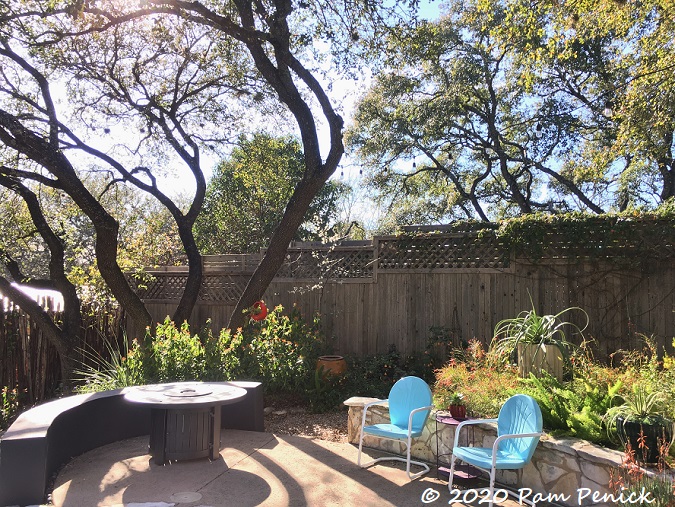
A wide view shows that our live oaks are dropping last season’s leaves. You wouldn’t believe how much blowing and raking I did to get this clean shot. Sharp-eyed readers will also notice that I got rid of our old rusty, wood-burning fire pit and replaced it with a propane-burning fire table. While it doesn’t put out as much heat, it’s oh so easy to light and turn it off when you’re done. And no smoke pollution or flying sparks either. Of course s’mores are out of the question…
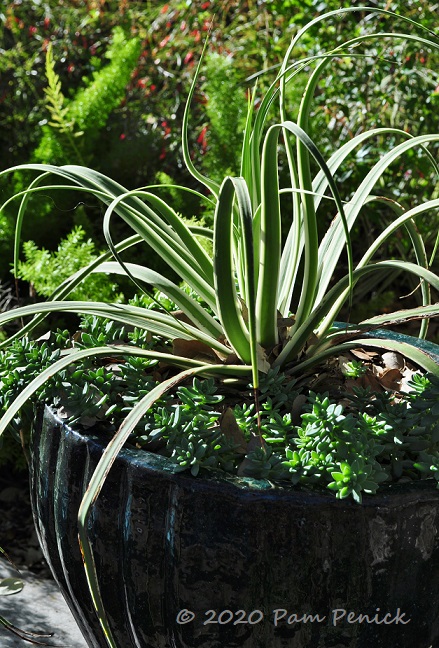
Variegated squid agave ‘Monterrey Frost’ looks pretty in an emerald-green pot underplanted with a creeping succulent.
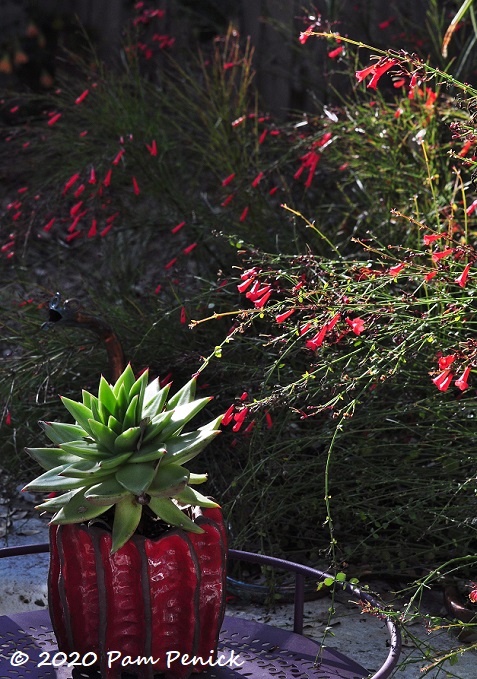
And a red-potted aloe glows alongside light-catching roundleaf firecracker fern. I just put all my tender potted plants like the aloe back out on the patios, which no doubt means a late-season cold snap is due any time.
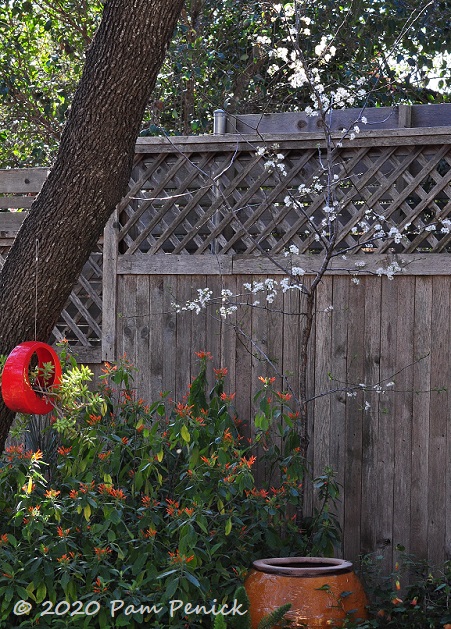
Spicy-scented Mexican plum and Mexican honeysuckle in the back corner.
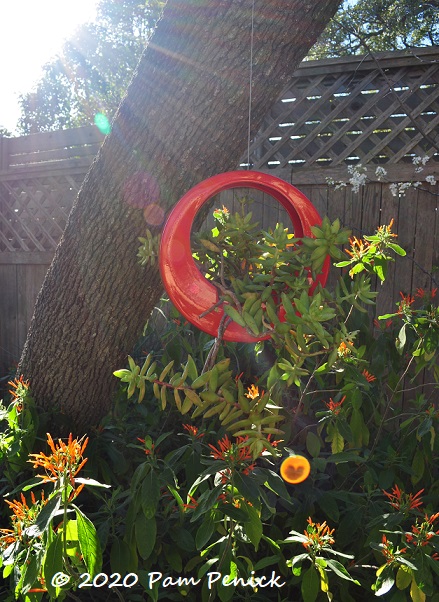
A red Circle Pot planted with orange-tinged Coppertone sedum pairs with the orange flowers of Mexican honeysuckle.
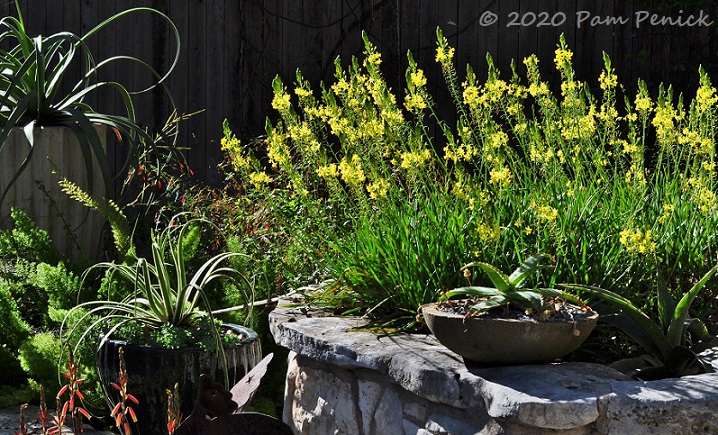
But let’s get back to that yellow bulbine.
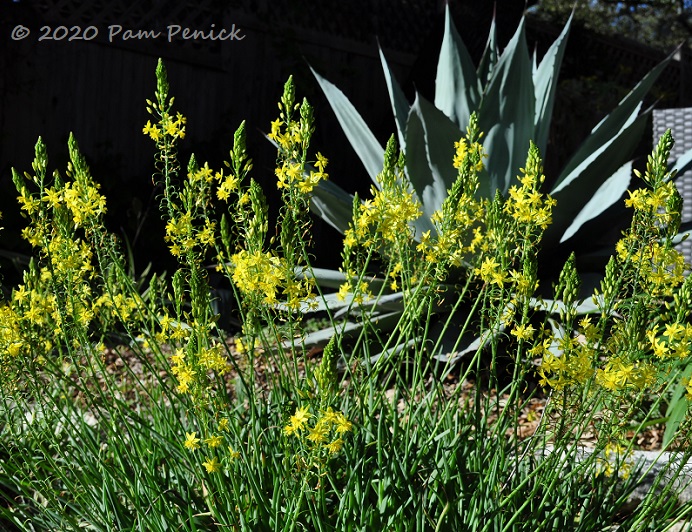
Seen from another angle, it echoes the spiky, upright flukes of a whale’s tongue agave.
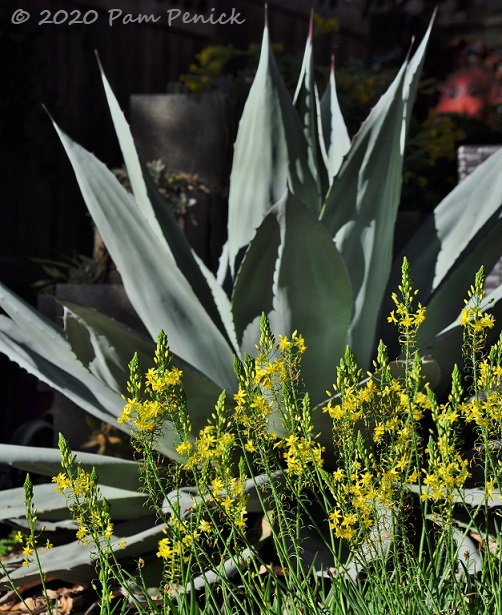
Muscular vs. delicate
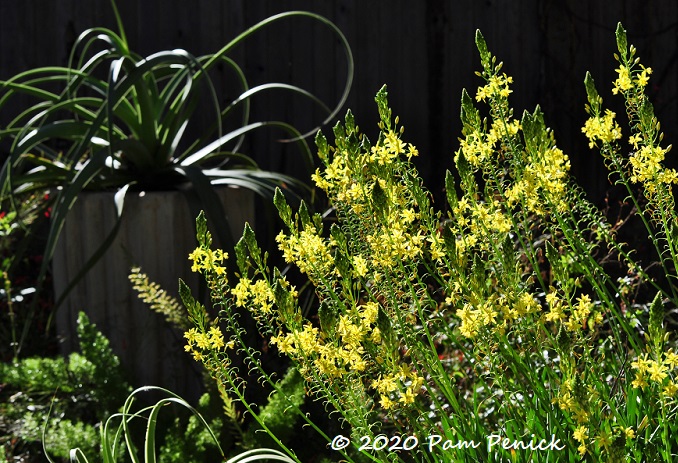
And what a light-catching plant!
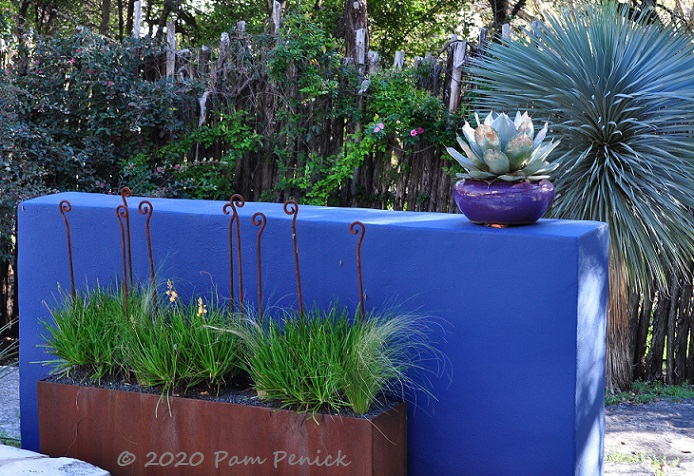
The orange bulbine in the steel planter is just starting to bloom. A few pink ‘Peggy Martin’ roses also have appeared on the rose climbing the cedar-post fence. But the hot-pink flowers of the loropetalum at back-left are already done.
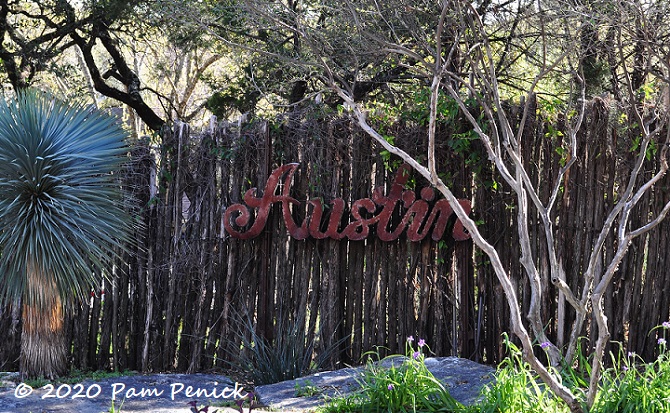
In the lower garden, a few volunteer spiderworts seeded themselves into cracks in the rock and are now blooming. The white trunks of a native Texas persimmon stand out against the dark posts of the coyote fence.
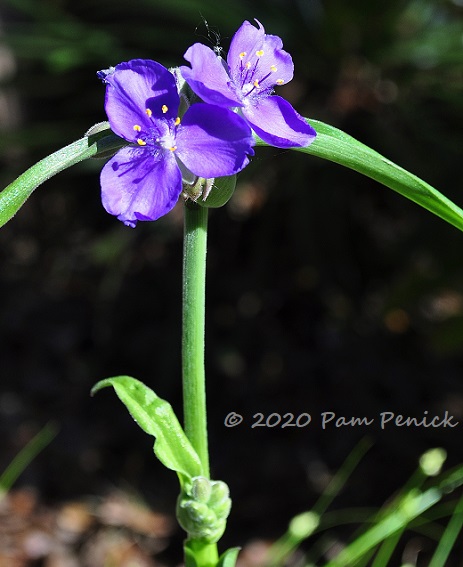
Spiderwort is a native, shade-loving wildflower with an unlovely name.
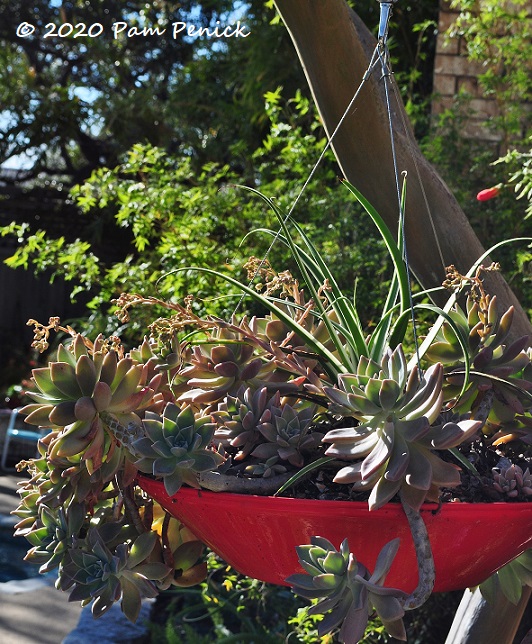
Ghost plant jostles for space with a variegated squid agave in an orange dish planter hanging from a crape myrtle. I leave this pot outside all winter, although I do put it on the ground so the plants can absorb a little heat from the soil.
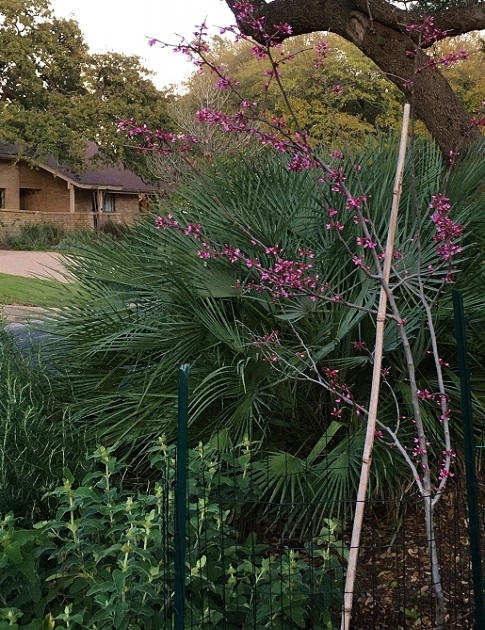
Out front, a new Mexican redbud is blooming against a bold-foliage backdrop of silver Mediterranean fan palm and Jerusalem sage. The sage will be next to flower.
This time of year is always a visual contest between annoying drifts of live oak leaves and pollen catkins and the beauty of spring blossoms. I can’t clean up the leaves and pollen fast enough, so I need to get better at overlooking them and appreciating the spring display. Gardening goals!
__________________________
Digging Deeper
Come learn about gardening and design at Garden Spark! I organize in-person talks by inspiring designers, landscape architects, authors, and gardeners a few times a year in Austin. These are limited-attendance events that sell out quickly, so join the Garden Spark email list to be notified in advance; simply click this link and ask to be added. Season 8 kicks off in fall 2024. Stay tuned for more info!
All material © 2025 by Pam Penick for Digging. Unauthorized reproduction prohibited.


There’s nothing like Bulbine backlit by the sun! I miss mine, which I pulled after allowing the rhizomes too much freedom (and time) to spread with abandon.
There can be too much of a good thing. Winter usually keeps ours in check, but that may be changing if winters become milder.
Bulbine was always reliable pretty flower. Thank you for sharing your lovely garden. I keep hunting nurseries for a few spiderwort plants. I had them growing wild in my old yard. Fun fact it can be called cow snot plant in some spots of Florida.
I have to say, “cow snot plant” gives “spiderwort” a run for the money for worst common name ever.
Such excitement in your garden. It makes me so anxious for spring to really get going here. Fun to see the blooms in your garden. I read that The agave you gave me would hold up in 10 degree weather. It could have been outside this winter here. Almost unheard of. I haven’t put him outside yet. I figure we are due our March snow yet. He is a brute. Those spines get more vicious as the years add up. Even so I do treasure him.
Would it really? I know that Agave ovatifolia can survive winters in Raleigh and Dallas. Indiana, I never would have guessed. Of course the killer for succulents isn’t always the cold so much as cold and wet, which leads to rot. I would advise keeping it in a pot with super sharp drainage, and just snip off the sharp spines if they start to get too vicious. It makes me happy to know your little Moby baby is doing well!
So pretty! I don’t see any oak pollen/leaves…all the gorgeous plants grab my attention. The color combo with that red circle pot is inspired!
Thanks, Renee. I did a lot of cleaning to achieve that temporary leaf-less look!
Wow, so many beautiful vignettes! Your yard is looking fantastic, and I just love the composition of that area in the second shot. It really glows. And the bulbine and artwork in front of the blue wall! I have to ask…what is that glowing little orange cat-face thing below the circle pot?!
That’s lens flare, Maggie. 🙂 The plant below the Circle Pot is Mexican honeysuckle (Justicia spicigera).
I always enjoy seeing your garden whether in person or pictures. I am envious of your Mexican Honeysuckle. How long did it take to get that large? I’ve got a couple of very small plants I put in last fall.
They grow pretty fast, Margo. I’d say about 2-3 years, if no hard freezes. In winters when we do get a prolonged hard freeze that blackens them, I cut them back hard in mid-February, before new growth begins. But for the past couple of years they haven’t been frozen back, and they’re getting big.